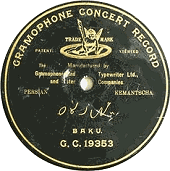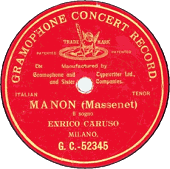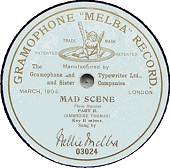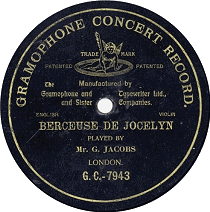Label
Sizes
Paper
labels for 7-inch Gramophone and 10-inch
Gramophone Concert records vary in overall
diameter, as well as in the diameter
of the outer ring. Both black and red
labels from 10-inch recordings made
in Paris during September 1901 and in
St. Petersburg in October-November 1901
have outer rings about 100 mm in diameter,
with overall diameters between 105 and
108 mm.
The
precise periods of usage for the various
sizes used are difficult to determine,
since the various manufacturing plants
undoubtedly used stocks of labels until
they were exhausted. The first paper
labels for 10-inch discs were used for
a very short time, probably not earlier
than January 1, 1902 and not later than
March 31, 1902. These first labels all
appear to have the raised The
variant,
which was dropped some time before April
1902. Nevertheless, the first five issued
first stamper pressings of Caruso’s
April 1902 recordings appear to have
this variant. The Chaliapin was probably
issued in early February 1902, having
been recorded between January 23 and
28, 1902. Battistini’s first recordings
made in February 1902 also show the
variant.
|
|
|
|
| Renaud,
Sep 1901 |
Vialtzeva,
Dec 1901 |
Casini
July 1901 |
 |
 |
 |
|
Feb
13, 1902
|
April
1902
|
March
1904!
|
One
of the earliest known 10-inch labels
is shown below for a recording made
by Fred Gaisberg in London in April
1901. It is a first stamper pressing
with a flush label 107 mm in overall
diameter. The matrix number under the
label is extremely faint.

G.C-7943,
London, April 1901
The
first change in label size occurred
when the label was placed on a raised
plateau, which was about 95 mm in diameter,
and the label size was reduced to fit.
Later labels (1902-1903) have an overall
diameter between 86 and 88 mm. This
size was used between February 19, 1903
and July 29, 1905, the so-called CO.
marking period, but toward the end of
it the label size was reduced to 90-92
mm in overall diameter, with an 80-81
mm outer ring. In general the overall
diameter of labels was about 10 mm.
greater than that of the outer ring.
Labels for 7-inch discs were about 60
mm in overall diameter in 1903. These
were considerably smaller than the label
used by the Victor Company in November
1901, which were 75 mm in diameter.
Labels
with an overall diameter of 96-100 mm
were in use by April 1902 and as late
as April 1904, but seem to have changed
after July 29, 1905. During that time
the diameter of the outer ring varied
between 80 and 83 mm. These differences
are not seen on any 12-inch labels,
which did not appear until June 1903,
after which the outer ring diameter
was reduced to 80-83 mm on all sizes.
|
|
|
|
Outer
ring 107 mm, July 1901
|
72
mm diameter, February 1902
|
Both
labels above were produced between February
19, 1903 and July 29, 1905, the so-called
CO. marking period, and both
have flush labels. The label on the
left is a stamper II pressing and is
raised, while that on the right is a
stamper III pressing; it is flush to
the record surface and a mere 72 mm
in diameter. Several other sizes are
found later, chiefly in conjunction
with the introduction of the DOG trademark
after 1908. Further changes reduced
the ring to as little as 67 mm. An exception
is the black and gold label 107 mm in
overall diameter, seen at the left below
on a stamper II pressing of a June 1901
recording, G.C.-52323, on a raised platform
of the same diameter, with a CO.
marking at 3 o’clock.
|
|
|
|
outer
ring 87 mm
March 1902
|
outer
ring 80 mm
after July 1905
|
Label
sizes were reduced during the acoustical
era, probably in an attempt to provide
increased recording time on the disc.
One can calculate that a 10-inch disc
with a label 108 mm in diameter with
a recordable area approximately 65 mm
wide from a rim 5 mm wide to the central
runoff area 10 mm wide, at the early
recording speed of about 67.92 rpm will
have an available recording time less
than 3 minutes and 30 seconds. (Author’s
note: had the turntable speed been the
"standard" 78.26 rpm, the
available time would have been reduced
to just about 3 minutes.) Such labels
were used well into the CO. marking
period. Reducing the overall diameter
of the label to 92-97 mm, might have
achieved an additional 30 seconds of
recording time. Shortly after July 1905
the overall diameter was reduced to
about 85 mm, and the recording time
for a 10-inch record could be extended
to as much as 4 minutes at the prevailing
recording speed. If one applies these
calculations to a 12-inch disc, the
recording time would have been about
4 minutes and 45 seconds, or just over
4 minutes at the higher "standard"
speed.
Pressings
from stampers I and III
of Gramophone Concert Record G.C.-52368
with a label raised on a plateau and
a pressing from stamper III II with
a flush label within a raised
ring all have outer ring diameters of
88 mm. On pressings from stampers VI
and VII of the same recording with
a sunken or flush label surrounded by
a raised ring, the outer ring diameter
is 80 mm.
The
two labels below show considerable differences,
although the overall diameters are identical.
The outer ring on the left measures
83 mm in diameter, while that on the
right is 87 mm. The words TRADE
and
MARK
on
the left are placed close to the trademark,
while those on the right are widely
spaced. The word TOSCA measures
24 mm on the left, and 28 mm on the
right. While the angels are the same
size, the distance across the two
PATENTED
is 55 mm on the left and 50 mm on the
right, which is in a smaller font size.
Both discs were pressed from stamper
VI of G.C.-52349.
The
"TRADE"
and
"MARK"
spacing
on earlier labels, e.g., November-December
1901 until some time after July 1905,
is narrow, while those on later pressings
are wide, as are the measurements across
PATENTED.
Note
the change in the font from serif to
nonserif for the former but not for
the latter. The names of both
the artist and the selection are more
widely spaced on later pressings. The
catalog number on early pressings is
slightly raised, while on later pressing
it is quite prominent. Earlier pressings
show the embossed matrix number about
mid-way between the label and the grooved
area at the 6 o’clock position, usually
in a different font from that of later
pressings, where it is next to the grooved
area. The latter usually has the engineer’s
suffix added, while earlier pressing
do not.
Label
Colours
Color
differentiation can be quite perplexing,
due in large extent to differences in
batches of ink used by the various printing
companies. Bennett lists violet, violet-red,
and red, but apparently distinguishes
them from the double-sided plum labels.
He lists the Melba issues as lilac-red,
while they are actually lilac, and assigns
pink-red to Farrar and Schumann-Heink,
but violet-red to Gluck. These all apply
to recordings listed in the English
Catalogue. Bennett makes no label color
assignments in his Italian Catalogue,
other than orange for Battistini. He
also assigned orange to the Chaliapin
pre-DOGS issues in the Russian Catalogue.
At a later date Clara Butt and John
McCormack received dark blue and purple
HMV labels, respectively.
Photos
of Gramophone Company labels in various
colors may be found throughout this
paper. Many labels may appear more than
once, since they are the best representation
of several categories listed in the
Outline provided below.
A. black
with gold lettering Jan 1901─April
1925
B. Red
with gold lettering Jun 1901─April
1925
C. Pink
with gold lettering (pre-DOG) 1906?─Aug
1910
D. Violet
red with gold lettering Feb 1906─July
1919
E. Caruso
(pale blue, pale green, pink) Sep
1907─Aug
1908
F. Caruso
(white, blue, green, pink) Aug 1908─April
1925
G. Dark
green with silver lettering Jan 1910
─Sep
1928
H. Dark
blue with gold lettering Aug 1910─10
Nov 1914
I. Plum
with gold lettering ─
the "B" and "C"
series Sep 1912─
1948
J. Black
with gold lettering ─
the "D" and "E"
series 1917─
1948
Whereas
Victor indicated their various price
categories according to the catalog
number series, the Gramophone Company
assigned label colors according to the
number of artists, as well as their
price. In fact, the number and category
of the artists often determined the
price, and hence the label color. The
Gramophone Company used eight distinctly
different label colors during the acoustical
era. Black labels with gold lettering
were used throughout the entire acoustical
era from December 10, 1900 to March-April
1925. Double-sided black label discs
on ten- and twelve-inch discs appeared
in September 1907.
Further
color and price variations were based
on the number of artists participating
in a recording. Thus, the Rigoletto
Quartet with Caruso, Abott, Homer, and
Scotti was priced at 31.25 lire (pale
blue), duets (on pale green) at 25 lire,
and his solos on pink labels at 16.50
lire. Pricing for other celebrities
varied accordingly. The listings below
are random selections, and by no means
indicate a complete survey of label
colors used during the acoustical era.
The
Gramophone Company used various label
colors at different periods of its development
to indicate the artist’s stature and
the price category of the issues record.
The following extract from John Bennett’s
1957 Italian Catalogue will serve
to indicate the colors, prices, and
standings of the artists and their records
during the first two decades of the
last century. The dollar values in brackets
have been added by the author, and are
based on an estimated exchange rate
during the period of approximately L.
6.25 per one U.S. dollar. It is probably
a unique reference to the prices of
Gramophone’s various record issues for
that early period.
"In
March 1903 Black Label "Piccoli"
(7") and "Concerto"
(10") were catalogued at L.3.50
[56 cents] and L.6.25 [$1.00]. In
the same list were Red
Labels of Pinto, Bruno, Sammarco,
Caruso, De Lucia, Garbin, Battistini,
and Giraldoni at L.12.50 [$2.00].
In November "Monarch" (12")
Black Labels were priced at L.9.50
[$1.52], with some Celebrity Red
Labels of Joachim, the famous violinist,
at L.18.75 [$3.00].
"It
is interesting to note the Company’s
assessment of probable demand for
an artist at a particular time by
the prices fixed. For example, in
August 1904 a 10 inch Tamagno sold
at L.25 [$4.00]; other celebrities
were "Monarch" L.18.75 [$3.00],
"Concert" L.12.50 [$2.00]
and "Piccoli" L.7.50 [$1.25].
Ruffo "Monarch" were L.15.75
[$2.52] and "Concert" L.10.00
[$1.60]. In April 1905 a 12 inch Tamagno
was listed at L.25 [$4], Caruso, Giorgini
and Boninsegna at L.18.75 [$3]; Melba
slightly surpassed Tamagno at L.26.50
[$4.25]. The following month Sembrich
"Monarch" stood at L.12.75
[$2.05]. In December 1906 Ruffo was
priced at L.18.75 [$3]; Patti was
placed a little below Melba at L.25
[$4]. In May 1906 Caruso advanced
to L.25 [$4]; in October three Red
Label artists─Cucini,
Sembrich and Eames─
were sold at L.18.75 [$3]; De Lucia
"Concert" were L.12.50 [$2]
and Monarch" L.18.50 [$2.80].
In January 1907 Battistini, Ruffo
and Galvany joined De Lucia at his
level. Melba, Patti and Tamagno Red
Labels were L.26.50 [$4.24], L.25
[$4], and L.25 {$4}, but Caruso at
L.25 [$4] was accorded Pink
Label status, as was Patti a little
later.
"September
1907 witnesses the probable first
appearance of the double-sided Black
Label "Concert" L. 6.25
[$1]; "Monarch" L.9.50 [$1.50].
The name of Calvé was added
to the Celebrity band at L.15.75 [$2.50]
for 12 inch Pink
labels. The previous month Caruso,
Abott, Homer and Scotti appeared in
the "Rigoletto" Quartette
at L.31.25 [$5] (Pale
Blue);
Caruso duets on Pale
Green
Label
at L.24 [$3.85]; Battistini’s Orange
Label, Patti’s Pink
and Melba’s Lilac
all realized L.15.75 [$2.50], as distinct
from the slightly lower Reds
of De Lucia, Giorgini, Ruffo, Journet,
Boronat, Galvany, Cucini, Frascano,
and De Tura at L.11.25 [$1.75]. In
1908 Ruffo, De Tura and Tetrazzini
were upgraded to Pink;
Marconi, Scampini, Pareto and De Cases
were Red.
In August 1908 Caruso’s list issued
white
at
L.35.50 [$6],
Blue
L.31.25 [$5], Green
L.25 [$4], Pink
L.16.50 [$2.75], andL.11 [$1.75],
whereas a year earlier his list had
read Blue
L.31.25 [$5], Green
L.25 [$4], and Pink
L.15.75 [$2.50] and L.10 [$1.75],
there being no White label.
"The
Angel Trademark was still in used
in February 1910; in March the Dog
appeared on the back page of the catalogue,
in November on the front page. In
the following year the Angel and the
Dog represented the official Trade
Mark, both featured on the from page
of the February list and finally,
in November 191, attention was drawn
to the Dog as representing the principal
Trade Mark of the Company..
"In
December 1916 all new Black Labels
went over to double-sided form and
from the 15th October 1917
new wartime prices came into effect
with "Red Concert" advancing
from L.8 to L.9 and "Monarch"
from L.12 to L.13.50, Pink
and
Lilac fro L.11 to L.12 and from L.16.50
to L.17.50, Violet fro L.6 to L.7
and from L.8.5 to L.10. The new double-sided
Black Label advanced from L.6.75 to
L.8 and from L.10 to L.12. The prices
of the dearer records remained unchanged
─White
(Sextette) 12 inch L.37.50, Pale
Blue
(Quartette) 12 inch L. 31.25, Pale
Green
(Duet) 12 inch L.25 and
Buff
10
inch L.16.50, 12 inch L. 21. On the
1st of August 1919 Black
Label rose to L.12.50 and L.19.50,
but two years later, from the 1st
of July 1921, the ceiling prices of
the ware began to return to more normal
levels, so that Black Label, Red
and Violet
from L.30 to L.25 and from L.44 to
L.35; Buff
L.36
to L.27 and L.48 to L.38; Pale
Green
12
inch from L.50 to L.40; Pale
Blue
12 inch from L.55 to L.45; White 12
inch from L.58 to L.42. The higher
ranking Battistini, Chaliapin and
Patti 12 inch L.58 also fell to L.42,
while the 10 inch Tamagno at L.63
were reduced to L.50.
"In
1918 His Master’s Voice records were
issued through the Italian Catalogue
for British and American troops in
Italy under the well known "B"
and "C" English series;
both the Angel and the Dog marks made
an appearance in these lists.
"The
name of Gigli appeared in a supplement
dated the 1st of February
1919, Dragoni in August, Schipa in
January 1920, Heifetz and Elman in
March, Poli-Randacio in September,
Besanzoni in May 1921, Zenatello in
June.
"On
the 1st of August 1924
Celebrity catalogue records were first
given DA and DB letters. Together
with the old single-sided numbers,
but the General Catalogue of the 1st
June omits the old numbers altogether.
Prices for these new issues on the
1st December were L.35
for the "DA", L.45 for "DB",
L.35 for "DJ", L.46 for
"DK", L.48 for "DM",
L.53 for "DO", L.54 for
"DQ".